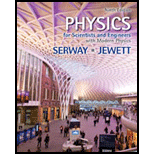
The change in fraction of the particles that are reflected changes as the barrier height is reduced to
Answer to Problem 1OQ
Option (b), It decreases.
Explanation of Solution
Write the expression for the transmission coefficient.
Here,
Write the equation for the reflection coefficient.
Here,
When the barrier height is reduced, the difference between the barrier height and the energy of the particles decreases. According to equation (I), T increases with decrease in
Conclusion:
Since reflection coefficient decreases with decrease in potential barrier, option (b) is correct.
Since the reflection coefficient decreases with decrease in potential barrier, option (a) is incorrect.
Since the reflection coefficient changes with decrease in potential barrier, option (c) is incorrect.
Since the reflection coefficient changes with decrease in potential barrier, option (d) is incorrect.
Since the reflection coefficient changes with decrease in potential barrier, option (e) is incorrect.
Want to see more full solutions like this?
Chapter 41 Solutions
Physics for Scientists and Engineers With Modern Physics
- A quantum mechanical oscillator vibrates at a frequency of 250.0 THz. What is the minimum energy of radiation it can emit?arrow_forwardFor a quantum particle of mass m in the ground state of a square well with length L and infinitely high walls, the uncertainty in position is Δx ≈ L. (a) Use the uncertainty principle to estimate the uncertainty in its momentum.(b) Because the particle stays inside the box, its average momentum must be zero. Its average squared momentum is then ⟨p2⟩ ≈ (Δp)2. Estimate the energy of the particle. (c) State how the result of part (b) compares with the actual ground-state energy.arrow_forward3. In a particular semiconductor device, an oxide layer forms a barrier 0.6 nm wide and 9V high between two conducting wires. An electron beam is accelerated through a 4V potential so that each electron approach the barrier with an energy of 4 eV. (a) What percent of the incident electrons will tunnel through the barrier? (b) Is aa for this system much larger than one, much less than one, or the same order of magnitude as one? Can we approximate the transmission coefficient using the formula below? - 16 (1-E) e E Vo T= 16; e-2aa (1) (c) Find the transmission coefficient using Eq. 1 and compare with your answer from part (a). Was Eq. 1 a good approximation?arrow_forward
- A photon passes through a horizontal slit of width 5 × 10-6 m. What uncertainty in the vertical position will this photon have as it emerges from the slit? What is the minimum uncertainty in the vertical momentum?arrow_forwardElectrons with an energy of 0.610 eV are incident on a double slit in which the two slits are separated by 40.0 nm. (a) What is the speed of these electrons? m/s (b) What is the de Broglie wavelength (in nanometers!) of these electrons? nm (c) What is the angle between the two second-order maxima in the resulting interference pattern?arrow_forwardScanning and tunneling electron microscopes are used to measure high resolution scientific images. As a general rule, the wavelength of the electrons must be at least as small as the item being scanned in order to detect/image the presence of the item. The new novel coronavirus has a size of 60 nm to 140 nm. The crowns or "corona" which are the protien like structures that extend from the body of the virus and have a length of 7 nm to 10 nm. The image above was taken at Rocky Mountain Laboratories in Montana, USA, using a tunneling electron microscope (TEM). What approximate size of wavelength was used to produce the image? 160 nm O 80 nm O 20 nm O 5 nm ооооarrow_forward
- When an electron in a one-dimensional box makes a transition from the n = 1 energy level to the n = 2 level, it absorbs a photon of wavelength 426 nm. What is the wavelength of that photon when the electron undergoes a transition (a) from the n = 2 to the n = 3 energy level and (b) from the n = 1 to the n = 3 energy level? (c) What is the width L of the box?arrow_forwardWhen a beam of electrons is directed at a suitably narrow pair of slits, a)one bright region with intensity decreasing exponentially on each side is observed at a screen behind the double slit. b)alternating areas of bright intensity and low intensity are observed behind the double slit. c)all the electrons pass through one slit and a single, sharply defined region of bright intensity is observed. b)two areas of bright, sharply defined intensity are observed, one behind each slit.arrow_forwardAn electron is trapped within a sphere whose diameter is 5.40×10−155.40×10−15 m (about the size of the nucleus of a medium sized atom). What is the minimum uncertainty in the electron's momentum?arrow_forward
- A single beam of electrons shines on a single slit of width 3.3nm. A diffraction pattern (of electrons!) is formed on a screen that is 2.1m away from the slit. The distance between the central bright spot and the first minimum is 2.1cm.What is the speed (m/s) of the electrons?Make use of the small angle approximation.arrow_forwardIn an electron microscope, the nonrelativistic electron beam is formed by a setup similar to the electron gun used in the Davisson– Germer experiment. The electrons have negligible kinetic energy before they are accelerated. What accelerating voltage is needed to produce electrons with wavelength 10 pm = 0.010 nm (roughly 50,000 times smaller than typical visible-light wavelengths)?arrow_forwardElectrons with an energy of 0.842 eV are incident on a double slit in which the two slits are separated by 40.0 nm. What is the speed of these electrons?arrow_forward
 Principles of Physics: A Calculus-Based TextPhysicsISBN:9781133104261Author:Raymond A. Serway, John W. JewettPublisher:Cengage Learning
Principles of Physics: A Calculus-Based TextPhysicsISBN:9781133104261Author:Raymond A. Serway, John W. JewettPublisher:Cengage Learning University Physics Volume 3PhysicsISBN:9781938168185Author:William Moebs, Jeff SannyPublisher:OpenStax
University Physics Volume 3PhysicsISBN:9781938168185Author:William Moebs, Jeff SannyPublisher:OpenStax

